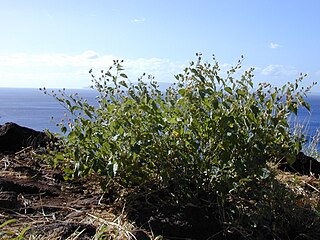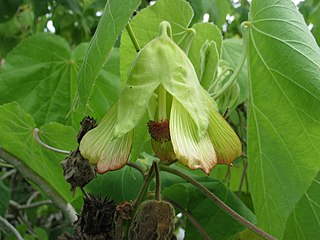
Abutilon is a large genus of flowering plants in the mallow family, Malvaceae. It is distributed throughout the tropics and subtropics of the Americas, Africa, Asia, and Australia. General common names include Indian mallow and velvetleaf; ornamental varieties may be known as room maple, parlor maple, or flowering maple. The genus name is an 18th-century Neo-Latin word that came from the Arabic ’abū-ṭīlūn, the name given by Avicenna to this or a similar genus.

Abutilon menziesii, known as Koʻoloaʻula in Hawaiian, is an endangered species of flowering shrub in the family Malvaceae, that is endemic to Hawaii.

Abutilon pictum, syn. Abutilon striatum (disputed), is a species of flowering plant in the family Malvaceae. It is native to southern Brazil, Argentina, Paraguay and Uruguay. The plant has become naturalised in Central America, and is used in horticulture. Common names include redvein abutilon, red vein Indian mallow, redvein flowering maple, Chinese-lantern and red vein Chinese lanterns.

A schizocarp is a dry fruit that, when mature, splits up into mericarps.

Abutilon icanum, also known as hoary abutilon, pelotazo, pelotazo chico, tronadora, and maʻo (Hawaiʻi), is a shrub widespread throughout the arid, warm regions of the southwestern United States and northern Mexico as well as Hawaiʻi.

Abutilon eremitopetalum, commonly known as the hidden-petaled abutilon or hiddenpetal Indian mallow, is a species of flowering shrub in the mallow family, Malvaceae. It is endemic to dry forests and low shrublands on the windward side of the island of Lānaʻi in Hawaii. It is classified by the IUCN Red List as critically endangered by habitat destruction. The species was first discovered in 1987.

Abutilon sandwicense, commonly known as the greenflower Indian mallow, is a species of flowering plant in the mallow family, Malvaceae, that is endemic to the island of Oʻahu, Hawaii, in the United States. It inhabits dry forests on the slopes of the Waiʻanae Range at elevations of 400–600 m (1,300–2,000 ft). Associated plants include lama, ēlama, māmaki, kalia, āulu, olopua, and alaheʻe. Greenflower Indian mallow is a shrub, reaching a height of 1.5–3 m (4.9–9.8 ft). It is threatened by habitat loss.

Abutilon grandifolium, the hairy Indian mallow, is a large shrub that is up to 3 m (9.8 ft) high with broad, 3–18 cm (1.2–7.1 in) leaf blades. Flowers are axillary, with a yellow corolla 2–3.5 cm (0.8–1.4 in) across, composed of petals 1–1.5 cm (0.4–0.6 in) long. The fruits are ovoid-globular schizocarps that are 1–1.5 cm (0.4–0.6 in) in diameter and composed of ten shortly beaked mericarps, containing 2-3 seeds each.
Mimoschinia is a genus of moths of the family Crambidae. It contains only one species, Mimoschinia rufofascialis, the rufous-banded pyralid moth or barberpole caterpillar, which is found in the Caribbean, from Alberta to British Columbia, south to Texas and California and in Mexico.

Burnsius oileus, the tropical checkered skipper, is a species of skipper. It is found in the United States, south through the West Indies, Mexico and Central America to Costa Rica. It was transferred to genus Burnsius in 2019, and was previously known as Pyrgus oileus.
Amyna natalis, the ilima moth, is a moth of the family Noctuidae. It was first described by Francis Walker in 1858. It is widespread from tropical Asia into northern Australia. It is an introduced species in Hawaii, where it is found on Oahu.
Udea nigrescens is a moth of the family Crambidae. It is endemic to the Hawaiian islands of Kauai, Oahu, Molokai and Maui.
Crocidosema leprarum is a moth of the family Tortricidae. It was first described by Lord Walsingham in 1907. It is endemic to the Hawaiian islands of Oahu, Molokai, Nihoa, Necker, French Frigate Shoals and Laysan.
Phyllonorycter stephanota is a moth of the family Gracillariidae. It is known from New South Wales and Queensland in Australia.

Abutilon mosaic virus (AbMV) is a virus of the genus Begomovirus. It infects Abutilon species, notably the flowering maple, Abutilon striatum. The mottled or variegated effect on the leaves of Abutilon striatum is sought after.

Abutilon guineense is a species of flowering plant in the mallow family, Malvaceae. It has a broad distribution in Africa and has been introduced elsewhere. It may comprise more than one species, with others yet undescribed. In China it occurs in Hainan, Sichuan, and Yunnan.

Abutilon cryptopetalum is a flowering plant in the family Malvaceae. It is a small, upright shrub with yellow or cream-white flowers and variable shaped grey-green leaves and grows in New South Wales, South Australia, Western Australia and the Northern Territory.

Abutilon lepidum is a flowering plant in the family Malvaceae. It was first described in 1868 as Sida lepida by Ferdinand von Mueller, but was transferred to the genus, Abutilon, in 1980 by Andrew Stewart Mitchell. The species epithet, lepidum, comes from the Latin adjective, lepidus, which means pleasant, charming, or elegant.












